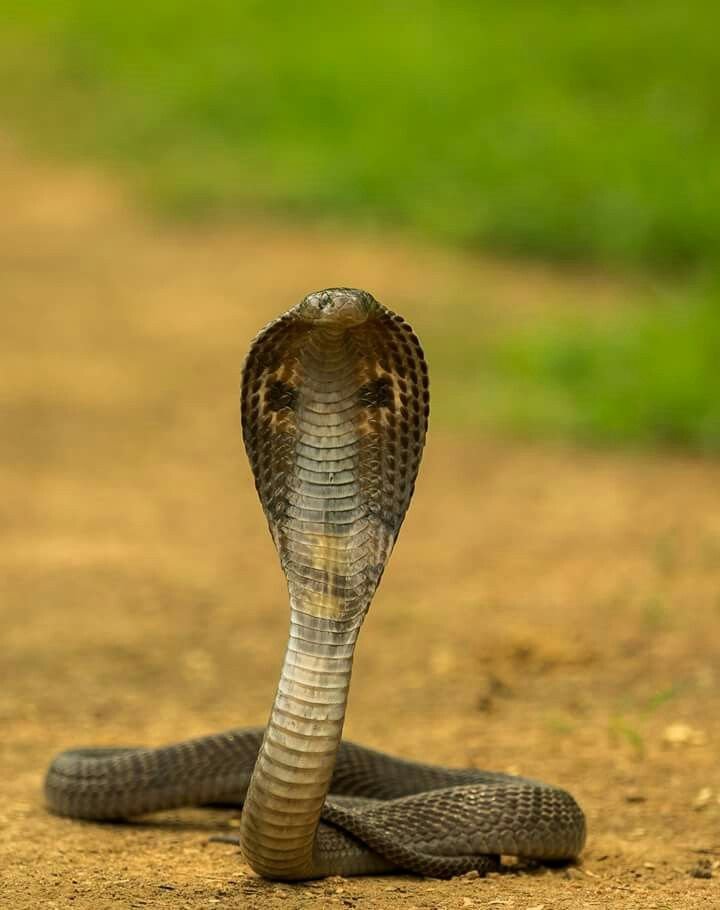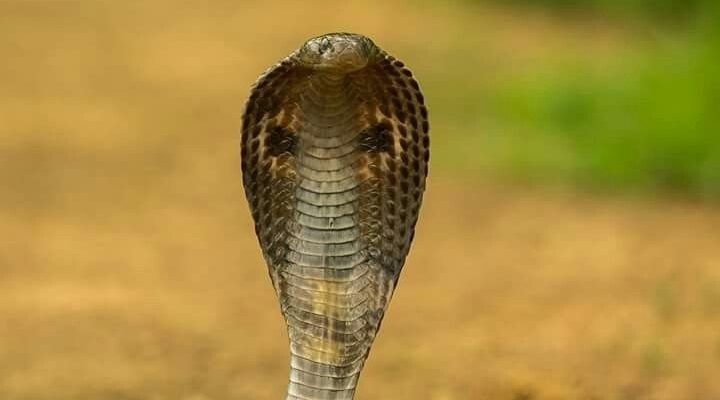
So, what makes the Indian cobra unique, and how can you spot its lookalikes? Let’s take a closer look. This guide will introduce you to 10 animals that resemble the Indian cobra, highlighting their key traits and how to differentiate between them. Think of this as a charming little chat about our reptilian friends, where we’ll dive into their differences and similarities in a way that’s easy to digest.
1. Egyptian Cobra
The Egyptian cobra is a close relative to the Indian cobra and can easily confuse snake enthusiasts. Known as *Naja haje*, this snake is famous for its striking appearance and venomous bite. Its hood is impressive, much like the Indian cobra’s, which it can expand when threatened.
One of the easiest ways to tell them apart is by their coloration. The Egyptian cobra typically has a lighter, golden brown hue with dark patches. In contrast, the Indian cobra can range from dark brown to black, with white or yellow markings. So, if you’re in Africa and see a snake with a lighter shade, you might be looking at an Egyptian cobra!
2. King Cobra
Next up is the king cobra, known for being the longest venomous snake in the world. Its scientific name, *Ophiophagus hannah*, translates to “snake eater,” which aptly describes its primary diet. The king cobra can reach up to 18 feet in length, making it a giant in the cobra family.
While its hood is similar to that of the Indian cobra, the king cobra boasts a more slender body. Its coloration can be olive green, brown, or even black, depending on its habitat. If you come across a cobra that’s larger and has a more elongated shape, you might just be looking at a king cobra.
3. Coral Snake
Now, let’s shift gears and meet the coral snake. While it’s not a cobra, this small but venomous snake shares some similarities, especially in terms of being feared for its bite. Coral snakes come in vibrant colors—red, yellow, and black—which can be eye-catching.
But remember, there’s a crucial difference in their coloring! Coral snakes have a distinct color pattern: the red and yellow bands touch each other. On the other hand, with cobras, such as the Indian cobra, the colors and patterns are quite different. If you see a snake with bands that don’t touch, you’re likely looking at a harmless mimic!
4. Black Mamba
The black mamba is another snake that shares some similar traits with the Indian cobra, particularly in its reputation for speed and venom. This snake, *Dendroaspis polylepis*, is native to Africa and can be quite aggressive if provoked.
You might wonder how to tell them apart. While the Indian cobra has a more rounded head, the black mamba has a distinctly elongated and angular one. Plus, the black mamba’s name comes from its inner mouth, which is dark black—not something you usually want to see up close!
5. Spectacled Cobra
If you think the Indian cobra is impressive, meet the spectacled cobra! This snake, found in India and surrounding areas, has a unique pattern that resembles a pair of glasses or spectacles on its hood. Its scientific name is *Naja naja*, and it’s famous for its defensive display.
When comparing it to the Indian cobra, you’ll notice that the spectacled cobra typically has a slight coloration difference and a more pronounced “spectacle” marking on its hood. If you’re in India and spot a cobra with these distinct patterns, you’ll know it’s a spectacled cobra.
6. Philippine Cobra
The Philippine cobra, or *Naja philippinensis*, is a lesser-known cousin of the Indian cobra that’s just as fascinating. This species is known for its ability to spit venom, which is quite the party trick if you ask me!
What sets it apart from the Indian cobra? The Philippine cobra usually has a more streamlined body and a slightly different color pattern, being more uniform in color. If you see a snake that appears more slender and has a spitting stance, it might just be this fascinating snake.
7. Northern Copperhead
The Northern copperhead is a non-venomous snake, and while it might not look like your traditional cobra, it’s worth mentioning because of its resemblance in color. This snake has a distinctive coppery hue with dark brown markings that might remind you of the Indian cobra’s patterns.
However, you’ll notice that the Northern copperhead is much chunkier and lacks the hood. This can make it easier to spot in the wild. Just remember: if it’s a chunky snake with a copper tone and no hood, you’re likely dealing with a Northern copperhead!
8. Green Tree Snake
The green tree snake, or *Dendrelaphis punctulatus*, may not look like a cobra at first glance, but it shares the environment and hunting style. This slender snake is often green, blending seamlessly into its leafy surroundings.
To differentiate it from the Indian cobra, you’ll want to focus on its body shape and size. Green tree snakes are long and slender, while cobras generally have a thicker body. Plus, the absence of a hood is a giveaway! If you’re in a tropical area and spot a thin, green snake in the trees, it’s probably a green tree snake.
9. Black-Headed Python
The black-headed python isn’t a cobra, but it’s worth mentioning because of its unique appearance. These pythons have a distinct head that is black or dark brown, while their bodies are typically lighter in color.
When comparing it to an Indian cobra, you’ll see a stark difference in body shape. Pythons are thicker and lack the hood that cobras are known for. If you spot a snake that’s hefty with a contrasting head, you might be observing a black-headed python!
10. Banded Krait
Lastly, let’s talk about the banded krait. This snake is known for its beautiful bands of black and yellow that can sometimes draw comparisons to cobras. The banded krait is venomous, but it’s generally more docile and less aggressive than cobras, making it a fascinating creature to observe.
The primary difference is in their head shape and coloration. Banded kraits have a more rounded head compared to the cobra’s distinctive hood, and their banding pattern is different from the cobras’ scales. If you see a snake with bold bands and a rounded head, chances are you’re looking at a banded krait!
In conclusion, knowing about these 10 animals similar to the Indian cobra can deepen your understanding of these incredible reptiles. Each one has unique traits that set them apart while sharing certain characteristics with the Indian cobra. Next time you encounter a snake in the wild, you’ll feel more confident identifying it, and you might even impress your friends with your newfound knowledge! Remember, whether it’s a cobra or something else, it’s all about appreciating the diversity of our animal kingdom.

